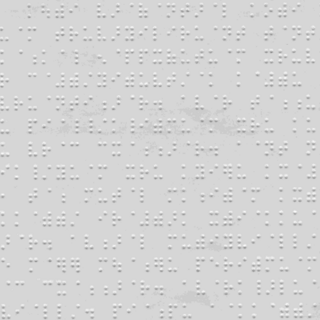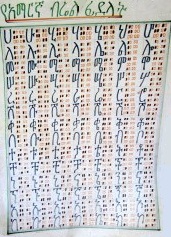
The Tibetan script is a segmental writing system (abugida) of Indic origin used to write certain Tibetic languages, including Tibetan, Dzongkha, Sikkimese, Ladakhi, Jirel and Balti. It has also been used for some non-Tibetic languages in close cultural contact with Tibet, such as Thakali and Old Turkic. The printed form is called uchen script while the hand-written cursive form used in everyday writing is called umê script. This writing system is used across the Himalayas, and Tibet.

Wylie transliteration is a method for transliterating Tibetan script using only the letters available on a typical English-language typewriter. The system is named for the American scholar Turrell V. Wylie, who created the system and published it in a 1959 Harvard Journal of Asiatic Studies article. It has subsequently become a standard transliteration scheme in Tibetan studies, especially in the United States.
Tibetan Braille is the Braille alphabet for writing the Tibetan language. It was invented in 1992 by German social worker Sabriye Tenberken. It is based on German braille, with some extensions from international usage. As in print, the vowel a is not written.

Bharati braille, or Bharatiya Braille, is a largely unified braille script for writing the languages of India. When India gained independence, eleven braille scripts were in use, in different parts of the country and for different languages. By 1951, a single national standard had been settled on, Bharati braille, which has since been adopted by Sri Lanka, Nepal, and Bangladesh. There are slight differences in the orthographies for Nepali in India and Nepal, and for Tamil in India and Sri Lanka. There are significant differences in Bengali Braille between India and Bangladesh, with several letters differing. Pakistan has not adopted Bharati braille, so the Urdu Braille of Pakistan is an entirely different alphabet than the Urdu Braille of India, with their commonalities largely due to their common inheritance from English or International Braille. Sinhala Braille largely conforms to other Bharati, but differs significantly toward the end of the alphabet, and is covered in its own article.
Arabic Braille is the braille alphabet for the Arabic language. It descends from a braille alphabet brought to Egypt by an English missionary prior to 1878, so the letter assignments generally correspond to English Braille and to the same romanization as in other braille systems, like Greek and Russian. However, there were once multiple standards, some of which were unrelated to Coptic Braille. A unified Arabic Braille was adopted in the 1950s as part of the move toward international braille, and it is the standard throughout the Arab world. Other Arabic-based alphabets have braille systems similar to Arabic Braille, such as Urdu and Persian Braille, but differ in some letter and diacritic assignments.
The goal of braille uniformity is to unify the braille alphabets of the world as much as possible, so that literacy in one braille alphabet readily transfers to another. Unification was first achieved by a convention of the International Congress on Work for the Blind in 1878, where it was decided to replace the mutually incompatible national conventions of the time with the French values of the basic Latin alphabet, both for languages that use Latin-based alphabets and, through their Latin equivalents, for languages that use other scripts. However, the unification did not address letters beyond these 26, leaving French and German Braille partially incompatible and as braille spread to new languages with new needs, national conventions again became disparate. A second round of unification was undertaken under the auspices of UNESCO in 1951, setting the foundation for international braille usage today.

Tamil Braille is the smallest of the Bharati braille alphabets.
Urdu Braille is the braille alphabet used for Urdu language. There are two standard braille alphabets for Urdu, one in Pakistan and the other in India. The Pakistani alphabet is based on Persian Braille and is in use throughout the country, while the Indian alphabet is based on national Bharati Braille.
Telugu Braille is one of the Bharati braille alphabets, and it largely conforms to the letter values of the other Bharati alphabets.
Gujarati Braille is one of the Bharati braille alphabets, and it largely conforms to the letter values of the other Bharati alphabets.
Odia Braille is one of the Bharati braille alphabets. Apart from using Hindi æ for Odia ẏ, it conforms to the letter values of the other Bharati alphabets.
Kannada Braille is one of the Bharati braille alphabets, and it largely conforms to the letter values of the other Bharati alphabets.
Malayalam Braille is one of the Bharati braille alphabets, and it largely conforms to the letter values of the other Bharati alphabets.
Sinhala Braille is one of the many Bharati braille alphabets. While it largely conforms to the letter values of other Bharati alphabets, it diverges in the values of the letters assigned toward the end of those alphabets.
Similar braille conventions are used for three languages of India and Nepal that in print are written in Devanagari script: Hindi, Marathi, and Nepali. These are part of a family of related braille alphabets known as Bharati Braille. There are apparently some differences between the Nepali braille alphabet of India and that of Nepal.
IPA Braille is the modern standard Braille encoding of the International Phonetic Alphabet (IPA), as recognized by the International Council on English Braille.

Ge'ez Braille is the braille alphabet for all Ethiopic languages. Letter values are mostly in line with international usage.

Burmese Braille is the braille alphabet of languages of Burma written in the Burmese script, including Burmese and Karen. Letters that may not seem at first glance to correspond to international norms are more recognizable when traditional romanization is considered. For example, သ s is rendered ⠹th, which is how it was romanized when Burmese Braille was developed ; similarly စ c and ဇ j as ⠎s and ⠵z.
Khmer Braille is the braille alphabet of the Khmer language of Cambodia.
Inuktitut Braille is a proposed braille alphabet of the Inuktitut language based on Inuktitut syllabics. Unlike syllabics, it is a true alphabet, with separate letters for consonants and vowels, though vowels are written before the consonants they follow in speech. It was published in 2012 by Tamara Kearney, Manager of Braille Research and Development at the Commonwealth Braille and Talking Book Cooperative. The book ᐃᓕᐊᕐᔪᒃ ᓇᓄᕐᓗ The Orphan and the Polar Bear was the first work transliterated into Inuktitut Braille.




